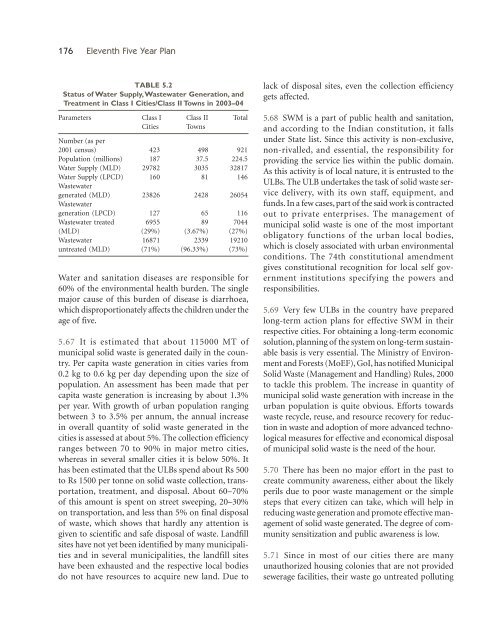Eleventh Five Year Plan
Eleventh Five Year Plan
Eleventh Five Year Plan
Create successful ePaper yourself
Turn your PDF publications into a flip-book with our unique Google optimized e-Paper software.
176 <strong>Eleventh</strong> <strong>Five</strong> <strong>Year</strong> <strong>Plan</strong>TABLE 5.2Status of Water Supply, Wastewater Generation, andTreatment in Class I Cities/Class II Towns in 2003–04Parameters Class I Class II TotalCities TownsNumber (as per2001 census) 423 498 921Population (millions) 187 37.5 224.5Water Supply (MLD) 29782 3035 32817Water Supply (LPCD) 160 81 146Wastewatergenerated (MLD) 23826 2428 26054Wastewatergeneration (LPCD) 127 65 116Wastewater treated 6955 89 7044(MLD) (29%) (3.67%) (27%)Wastewater 16871 2339 19210untreated (MLD) (71%) (96.33%) (73%)Water and sanitation diseases are responsible for60% of the environmental health burden. The singlemajor cause of this burden of disease is diarrhoea,which disproportionately affects the children under theage of five.5.67 It is estimated that about 115000 MT ofmunicipal solid waste is generated daily in the country.Per capita waste generation in cities varies from0.2 kg to 0.6 kg per day depending upon the size ofpopulation. An assessment has been made that percapita waste generation is increasing by about 1.3%per year. With growth of urban population rangingbetween 3 to 3.5% per annum, the annual increasein overall quantity of solid waste generated in thecities is assessed at about 5%. The collection efficiencyranges between 70 to 90% in major metro cities,whereas in several smaller cities it is below 50%. Ithas been estimated that the ULBs spend about Rs 500to Rs 1500 per tonne on solid waste collection, transportation,treatment, and disposal. About 60–70%of this amount is spent on street sweeping, 20–30%on transportation, and less than 5% on final disposalof waste, which shows that hardly any attention isgiven to scientific and safe disposal of waste. Landfillsites have not yet been identified by many municipalitiesand in several municipalities, the landfill siteshave been exhausted and the respective local bodiesdo not have resources to acquire new land. Due tolack of disposal sites, even the collection efficiencygets affected.5.68 SWM is a part of public health and sanitation,and according to the Indian constitution, it fallsunder State list. Since this activity is non-exclusive,non-rivalled, and essential, the responsibility forproviding the service lies within the public domain.As this activity is of local nature, it is entrusted to theULBs. The ULB undertakes the task of solid waste servicedelivery, with its own staff, equipment, andfunds. In a few cases, part of the said work is contractedout to private enterprises. The management ofmunicipal solid waste is one of the most importantobligatory functions of the urban local bodies,which is closely associated with urban environmentalconditions. The 74th constitutional amendmentgives constitutional recognition for local self governmentinstitutions specifying the powers andresponsibilities.5.69 Very few ULBs in the country have preparedlong-term action plans for effective SWM in theirrespective cities. For obtaining a long-term economicsolution, planning of the system on long-term sustainablebasis is very essential. The Ministry of Environmentand Forests (MoEF), GoI, has notified MunicipalSolid Waste (Management and Handling) Rules, 2000to tackle this problem. The increase in quantity ofmunicipal solid waste generation with increase in theurban population is quite obvious. Efforts towardswaste recycle, reuse, and resource recovery for reductionin waste and adoption of more advanced technologicalmeasures for effective and economical disposalof municipal solid waste is the need of the hour.5.70 There has been no major effort in the past tocreate community awareness, either about the likelyperils due to poor waste management or the simplesteps that every citizen can take, which will help inreducing waste generation and promote effective managementof solid waste generated. The degree of communitysensitization and public awareness is low.5.71 Since in most of our cities there are manyunauthorized housing colonies that are not providedsewerage facilities, their waste go untreated polluting












![[Tam] Uygula[ya] - Bilim, Teknoloji ve Ä°novasyon Politikaları TartıÅma ...](https://img.yumpu.com/36820041/1/184x260/tam-uygulaya-bilim-teknoloji-ve-anovasyon-politikalara-tartaama-.jpg?quality=85)



